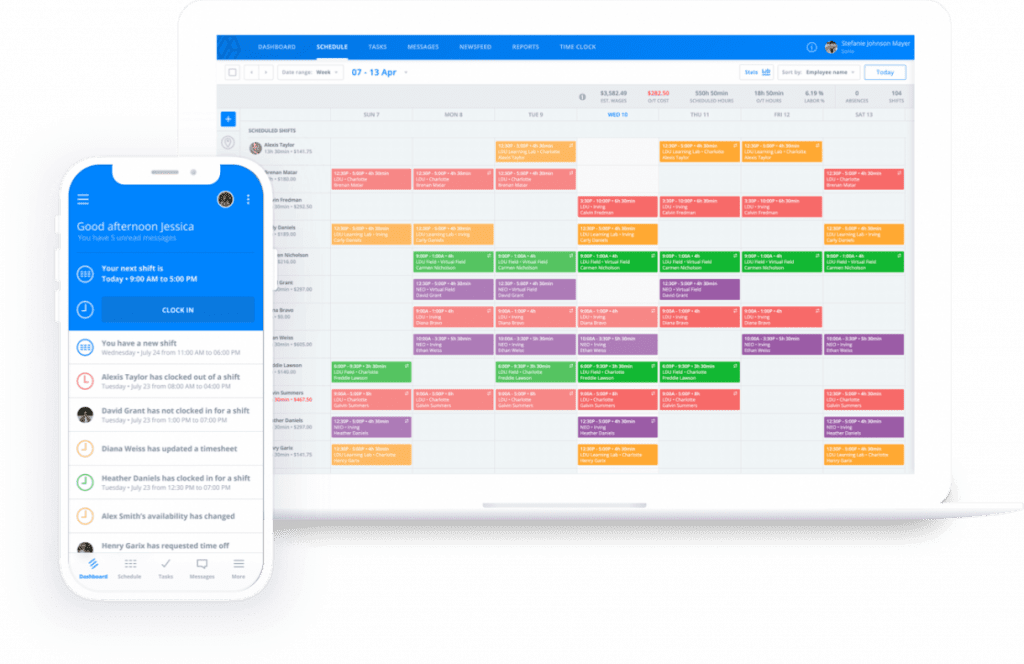10 Effects of Working Night Shifts (and How To Combat Them)
In many industries, the night shift is a necessary part of the regular workday. ...

If your business needs an on-call schedule, set it up in such a way that it doesn’t alienate your employees or negatively affect the unity of your team. How can you do that?
In this article, the workforce-management experts at Sling give you tips for creating an effective on-call schedule that won’t frustrate employees.

An on-call schedule is a staff rota that defines which team members are available to handle emergencies and other issues at all hours of the day or night.
On-call programs are especially useful for businesses that serve customers, users, or patients 24 hours a day, seven days a week, 365 days a year.
The medical profession, for example, uses an on-call schedule to ensure that a specialist is available to deal with emergencies should the need arise.
While ER doctors and nurses may work the night shift and provide care for the vast majority — if not all — of the patients that come through the door, there may be issues that they can’t handle (e.g., an acute case of appendicitis).
In that case, they would contact the on-call surgeon, who would come in and perform the necessary procedure.
On-call schedules are extremely common for doctors, but other industries use them, too.
IT professionals may have to deal with major bugs, capacity issues, or product downtime even in the middle of the night. For that reason, team members take turns being the first contact when those issues arise.

There are as many types of on-call schedules as there are businesses, so don’t be afraid to customize who works when in a way that best fits the needs of your team and your business.
Here are just a few examples of common on-call schedules that you can use as inspiration to create your own.
A follow-the-sun schedule does just as the name suggests: arranges on-call team members based on where they work. This type of arrangement is perfect for remote teams with members located across wide geographic areas.
One employee or another is available for emergencies during the day (i.e., their regular work hours) and your business doesn’t have to schedule a night shift.
This type of on-call schedule rotates team members through the responsibilities outlined by your business every other week (or twice a month).
A week/weekend schedule puts one set of team members on call during the week and another set of team members on call during the weekend.
This is especially useful if overnight hours are involved, as it gives employees a break from working the night shift.
A rotating on-call schedule allows your business to make changes on an hourly, daily, weekly, or monthly basis so that employees don’t get overwhelmed and overloaded.
This is less a type of on-call schedule and more of a process variable to contend with. Within whatever on-call arrangement you come up with, you also specify a primary contact and a secondary contact.
The secondary contact acts as a backup in the event that the primary contact misses a notification or is involved in another issue at the time.
Another process variable you may need to build into your rotating or semimonthly on-call schedule is expert availability.
Like the primary/secondary variable, expert availability provides another layer of contact should the other channels break down or not be able to handle a certain situation.
Tech support is a perfect example. If the primary and secondary contacts can’t resolve an issue — because, let’s say, it involves a part of the system they don’t have permission to enter — they can contact a system administrator who can provide access, walk them through the fix, or repair the problem themselves.
This, of course, would be a last-resort action after the primary and secondary contacts have exhausted all other attempts at a resolution.

Before you implement or revise your on-call schedule, talk to your team and get their input. They may prefer a different contact arrangement than you were initially considering.
If their preferences still satisfy the needs of your business, try that schedule first so that you don’t force your employees into a process they don’t want.
Being “on call” will mean something different for every business. Define what it is for your company so that employees understand their responsibilities.
To a doctor in a hospital, for example, the on-call designation may mean being the primary contact for related emergencies at all hours during the weekend. To an IT professional, it may mean being the primary contact during regular business hours.
Your business can define it however it wants, as long as the team members tasked with the duty are clear on what they’re doing.
Working overnight is difficult — especially for employees who are used to working daylight hours. If at all possible, avoid the night shift when creating your on-call schedule.
At the very least, stress the importance of only contacting individuals during the evening with serious issues. That way, they can get the sleep they need to be productive the next day while still providing emergency response should the need arise.
Being on call day and night is stressful. It interrupts your team’s regular workflow and impacts their life outside of work.
Providing support for on-call employees makes a huge difference in satisfaction, engagement, and effectiveness. And the most beneficial support comes from your business culture itself.
For example, if Lowell has a particularly long night dealing with a serious issue and Joe and Brian offer to take the next two days’ on-call shifts, it can be a huge relief to Lowell, who is already feeling the burden of being the primary contact.
Or, if Helen has a personal emergency, you want your team to step up, support her in her time of need, and assume responsibilities during her on-call shifts.
When you foster a company culture where team members take care of each other, you’ll find that the on-call schedule is much less stressful than it would be otherwise.
Every manager knows who on their team is capable of certain things and who isn’t. If they don’t, it’s time to make a list for quick and easy reference.
Depending on the schedule you’re building, consider traits such as:
Once you have your list of capabilities, build the on-call schedule around the team members best suited for a particular time or skill.
This serves two important purposes:
First, it ensures that the team member most suited to the task is the foundation of your schedule. So, for example, the most efficient and knowledgeable employee(s) are on call during peak hours, while those with a bit less knowledge and experience take the off-peak hours.
Second, building the on-call schedule around capabilities ensures that you know you have a core of experience on which other team members can rely.
So, for example, you can schedule a less experienced employee as the primary contact along with a more experienced employee as the secondary contact.
Arranging the schedule this way provides a “safety net” for the less experienced team member, who may find themselves in a jam.

While building your on-call schedule around capabilities is important, be sure to spread the responsibility evenly among all team members.
Any schedule that relies on a handful of people (or one individual) for its success is bound to fail eventually.
Overwork leads to disgruntled employees and burnout, both of which can adversely affect every aspect of your business.
Even though you want those employees with the most capabilities working peak on-call hours, sometimes you may have to schedule a team member with less experience so that you aren’t relying too heavily on the other employee.
Transparency these days is all about communication. Whether you’re communicating with your customers, the public at large, or upper management, providing access to information makes your business run better.
Fewer places is transparency more crucial than when creating an on-call schedule.
When it comes to scheduling — of any kind, really — communication and transparency can mean the difference between a successful shift and one that’s plagued with problems.
For the most effective transparency possible, establish a team-wide communication network so it’s easy for you and your employees to find important information.
With such a system in place, there’s no more searching through emails, IMs, and texts to find who’s on call and when. Everyone uses the same tool, so everyone’s on the same page.
With most people using smartphones these days, your best bet is to choose a communication method that makes use of this readily available technology.
Texting is one such method. Instant messaging is another. But even those quick and easy communication methods still come with a long list of difficulties.
A better option is the Sling app. This software program couples powerful scheduling tools with equally powerful communication features and allows you to improve internal communication through push notifications, chatting, and photo sharing.
Plus, all of the information is stored in one place. If an employee asks for a day off, Sling automatically links that request to the employee in question.
Then, when you go to access your schedule templates and produce an actual on-call schedule, the software reminds you not to schedule the employee for that day or time.
Employee preferences play a big role in keeping an on-call schedule flowing smoothly.
Honor each employee’s shift preferences and time-off requests whenever possible. Doing so serves to create a sense of goodwill among your team. It also increases employee engagement and satisfaction, which can help you retain good workers longer.
One of the most efficient ways to do this is to use a cloud-based master document similar to the document you used to create and distribute your schedule.
You can give your employees permission to add to this document and then ask them to submit their work and time-off preferences in this one location. It’s very much like having a time-off request box mounted on the wall in the break room, only this “box” is accessible anytime, anywhere.
After you establish how your employees submit their work preferences and time-off requests, it’s essential to set some rules to govern the process. Address things like when employees can and can’t request time off, how far in advance the request needs to be made, and so on.
For example, because of the way your on-call schedule is built, employees may only be able to take time off in blocks of five days or less. That should certainly be outlined in the rules.
You’ll then need to set the rules that determine how you decide between overlapping requests that can become more and more common as holidays approach.
You can tailor the rubric for settling employee-preference conflicts to fit each particular situation, but you should always consider things like seniority, reason for the request, what’s best for the business, and when the request was submitted.
Establishing rules like these serves to make the resolution process transparent to your employees. You can explain to employee A the specific reasons why you let employee B have a certain shift, rather than letting employee A think there was some sort of favoritism involved.
This keeps everyone happy, keeps everything running smoothly, and helps avoid conflicts between all parties involved.
When your employees know that they can get a day off from the on-call schedule or be scheduled for a different time, they’re less likely to start looking for a different job that will fit their needs better.
As we mentioned earlier in this article, burnout is a very real concern when it comes to on-call schedules and is characterized by:
If you see your team starting to exhibit the signs of burnout, consider changing your scheduling practices to provide a better work-life balance.
A lot of this goes back to honoring employee preferences as much as possible. One employee may be more willing to work overnight hours than peak hours because of family commitments during the day.
Honoring that preference helps the entire team and provides a better work-life balance for the employee.
This may seem like an obvious tip, but you’d be surprised how easy it is to forget to mark the schedule with a start date and time.
Chances are, at some point in the process, there will be multiple on-call schedules floating around. Including a start date and time in a prominent position helps avoid the confusion that comes when transitioning from an existing schedule to the next one in line.
If you need to make changes to an existing schedule in the middle of the rotation, it’s also extremely helpful to add a version number and a distribution date in a prominent place.
This helps distinguish between an out-of-date schedule and a new one and gives you something to refer to when instructing your team which copy to delete and which copy to keep.

The key to the perfect on-call schedule is choosing the right software.
With the best app in hand, you’ll be able to create both regular and on-call schedules that work for your business and won’t frustrate your employees.
Sling is that app.
Sling is an employee scheduler designed to bring order to the chaos. Sling simplifies all the issues that a manager could potentially face when scheduling employees, including:
But Sling is about more than just plugging names into time slots. It’s about making every aspect of the process — scheduling, distribution, communication — easier and faster.
The intuitive and well-organized scheduling tools Sling offers make it simple to create clear, easy-to-read schedules with just a few clicks of the mouse or taps on the screen. And Sling’s cloud-based platform streamlines the process of sending the schedule to everyone who needs it. Just post your schedule in the cloud for all to see.
You can even control exactly who can view the schedule and who can make changes to it. All you have to do is give individuals permission or send them a link. They can then log in to Sling to view or edit the schedule anytime, anywhere.
Sling’s cloud-based program also provides a central location where employees can indicate when they’re available to work. Sling then displays reminders about double-bookings, time-off requests, and unavailability while you’re creating your schedule.
But remember, Sling is about more than just scheduling.
The app also offers powerful messaging and communication tools that let you contact all your employees at the same time, a specific group of employees, or just one person. This cuts down on the difficult task of covering no-shows and coordinating substitutes.
Sling’s integrated features (Shifts, Time Clock, Messages, Newsfeed, Tasks) reduce the time it takes to create and manage your business’s schedules and employees.
In fact, Sling helps managers bring teams together, keep everyone informed and engaged, and build a better work culture.
Don’t reinvent the wheel every time you create an on-call schedule. Don’t rely on overly-simplified templates that can’t address all your needs. Don’t conform your business to the features of a sub-standard on-call schedule program or template.
Instead, let Sling show you how easy scheduling can be.
For more free resources to help you manage your business better, organize and schedule your team, and track and calculate labor costs, visit GetSling.com today to try the app for free.
See Here For Last Updated Dates: Link
This content is for informational purposes and is not intended as legal, tax, HR, or any other professional advice. Please contact an attorney or other professional for specific advice.
Schedule faster, communicate better, get things done.